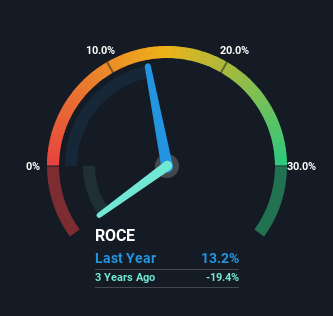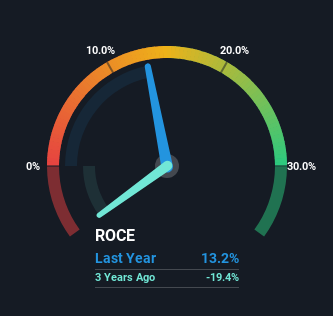What trends should we look for it we want to identify stocks that can multiply in value over the long term? Typically, we’ll want to notice a trend of growing return on capital employed (ROCE) and alongside that, an expanding base of capital employed. Ultimately, this demonstrates that it’s a business that is reinvesting profits at increasing rates of return. In light of that, when we looked at Delta Air Lines (NYSE:DAL) and its ROCE trend, we weren’t exactly thrilled.
Understanding Return On Capital Employed (ROCE)
Just to clarify if you’re unsure, ROCE is a metric for evaluating how much pre-tax income (in percentage terms) a company earns on the capital invested in its business. Analysts use this formula to calculate it for Delta Air Lines:
Return on Capital Employed = Earnings Before Interest and Tax (EBIT) ÷ (Total Assets – Current Liabilities)
0.13 = US$6.1b ÷ (US$75b – US$28b) (Based on the trailing twelve months to March 2024).
Therefore, Delta Air Lines has an ROCE of 13%. In absolute terms, that’s a satisfactory return, but compared to the Airlines industry average of 9.0% it’s much better.
See our latest analysis for Delta Air Lines
In the above chart we have measured Delta Air Lines’ prior ROCE against its prior performance, but the future is arguably more important. If you’d like to see what analysts are forecasting going forward, you should check out our free analyst report for Delta Air Lines .
So How Is Delta Air Lines’ ROCE Trending?
Over the past five years, Delta Air Lines’ ROCE and capital employed have both remained mostly flat. This tells us the company isn’t reinvesting in itself, so it’s plausible that it’s past the growth phase. With that in mind, unless investment picks up again in the future, we wouldn’t expect Delta Air Lines to be a multi-bagger going forward.
Our Take On Delta Air Lines’ ROCE
In summary, Delta Air Lines isn’t compounding its earnings but is generating stable returns on the same amount of capital employed. Since the stock has declined 22% over the last five years, investors may not be too optimistic on this trend improving either. All in all, the inherent trends aren’t typical of multi-baggers, so if that’s what you’re after, we think you might have more luck elsewhere.
If you want to continue researching Delta Air Lines, you might be interested to know about the 2 warning signs that our analysis has discovered.
While Delta Air Lines isn’t earning the highest return, check out this free list of companies that are earning high returns on equity with solid balance sheets.
Have feedback on this article? Concerned about the content? Get in touch with us directly. Alternatively, email editorial-team (at) simplywallst.com.
This article by Simply Wall St is general in nature. We provide commentary based on historical data and analyst forecasts only using an unbiased methodology and our articles are not intended to be financial advice. It does not constitute a recommendation to buy or sell any stock, and does not take account of your objectives, or your financial situation. We aim to bring you long-term focused analysis driven by fundamental data. Note that our analysis may not factor in the latest price-sensitive company announcements or qualitative material. Simply Wall St has no position in any stocks mentioned.
Have feedback on this article? Concerned about the content? Get in touch with us directly. Alternatively, email editorial-team@simplywallst.com
EMEA Tribune is not involved in this news article, it is taken from our partners and or from the News Agencies. Copyright and Credit go to the News Agencies, email news@emeatribune.com Follow our WhatsApp verified Channel






